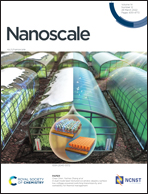Plasmon-assisted nanophase engineering of titanium dioxide for improved performances in single-particle based sensing and photocatalysis†
Abstract
Titanium dioxide (TiO2) due to its large bandgap, has a very limited efficiency in utilizing sunlight for photocatalysis and photoanode applications. Sensitizing with metallic nanoparticles is one of the promising routes for resolving this issue but it requires thermal annealing and proper bandgap engineering to optimize the Schottky junctions. Here we use plasmonic nanoheating to locally anneal the TiO2 medium with a sub-nanometer (sub-nm) feature, which results in a nanophase transition from amorphous TiO2 to anatase and rutile with a gradient configuration. Such gradient nanocoatings of rutile/anatase establish a cascade hot electron transfer via a conduction band and defect states, which improves the surface enhanced Raman scattering (SERS) performance and photocatalytic efficiency over an order of magnitude. Unlike conventional global annealing, this nanoannealing strategy with plasmonic heating enables sub-nm control at the interface between the metal and semiconductors, and this strategy not only provides new opportunities for single particle SERS, but also shows significant implications for photocatalysis and hot-electron chemistry.



 Please wait while we load your content...
Please wait while we load your content...